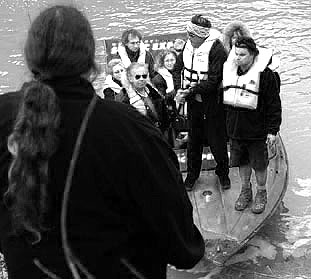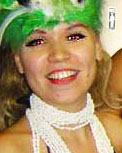|
NEW
ZEALAND
FO
LK
* SONG
|
E
Karanga E Te Iwi E |
|---|
| This powerful song of welcome echoes the women's karanga. It draws hosts and visitors together through a shared memory of loved ones who have been lost from the land, by both war and migration. While showing grief, the singers also express earth-shaking pride in the achievements of those who went away to the war, and later, those who have found a new way of life in the cities.
1. Te iwi e Tu-mat'-uenga!
is what we have sung so many times on our marae at
Waiouru Army Camp. We are Ngati Tu-mata-uenga, the
people of the war god, "He who stands with fierce eye".
This Youtube clip shows them performing it
in 1995 while peacekeeping in Bosnia.
2. Karanga This is the ceremonial call of welcome by women of the host group. The lamenting calls of the karanga clear a spiritual pathway between the visitors (manuhiri) and the local people (tangata whenua). Haere Mai. 3. Kua eke mai nei ki runga te marae e 
But in the old days visitors arrived by canoe, and stepped ashore lithe and strong, with muscles rippling. So this phrase is a nice compliment to the debussing city suits. In 2006 I photographed a karanga for some French bishops when they really did eke mai, from a jet boat. They were visiting Jerusalem on the Whanganui River and slips had closed the river road. More Ngati Wiwi pictures 4. Mauria mai ra e nga mate By bringing to mind the the dead of both groups, everyone is united in their shared grief. 5. Whanui e "Nation-wide." This song was first sung during World War II and requested support for the Maori boys fighting in Egypt. And after the war there was grieving for the hundreds of them who had died, from throughout the land. Maori Battalion. 6. Mahi o te motu "Working throughout the land." The migration to the cities began in the 1930s and greatly increased in the 1950s and 60s. These migrations are chronicled in the song Matangi. 7. Rā ana te whenua "The
land is shaking, the waters are trembling."
The
Maori are the people of the land, and their intense
emotions are entwined with the emotions of our
earthquaking landmass. This figure of speech is also
used in the waiata Pokarekare
Ana and the haka Kapa
o Pango.
|
Chords
|
Tumatauenga
toru wha |

Origins
This
song is sung in several versions. Toby Rikihana
writes in his book that
"Te Arawa" is the original version. It commemorates
the visit of the children from Omaio School, near
Opotiki, to Whaka-rewa-rewa Maori School at Rotorua
in the early stages of World War Two.
| Te
Arawa Pōwhiritia te iwi nei e Kua eke mai nei Ki runga te marae nei No reira rā Waipounamu Wharekauri e Awhinatia mai tō iwi Māori e Ihipa tēnā , Tiamana tēnā E hoariri mai nei e. Mura ana te whenua a Ki waho te moana e Aue te aroha te mamae I ahau e |
Te
Arawa greet these people who have arrived here at this marae Therefore South Islanders and Chatham islanders help the Maori people there in Egypt, there with Germany, fighting each other. The land is aglow And even out to sea. Aue! the love and pain within me |
|
My
thanks to Kirsi Terās of Mana-o-laka Pacific
Island Dance Group in Finland |
Kiwi
Songs - Maori
Songs - Home
Visitor counter started
June 2025
Get Visitor
Counters
